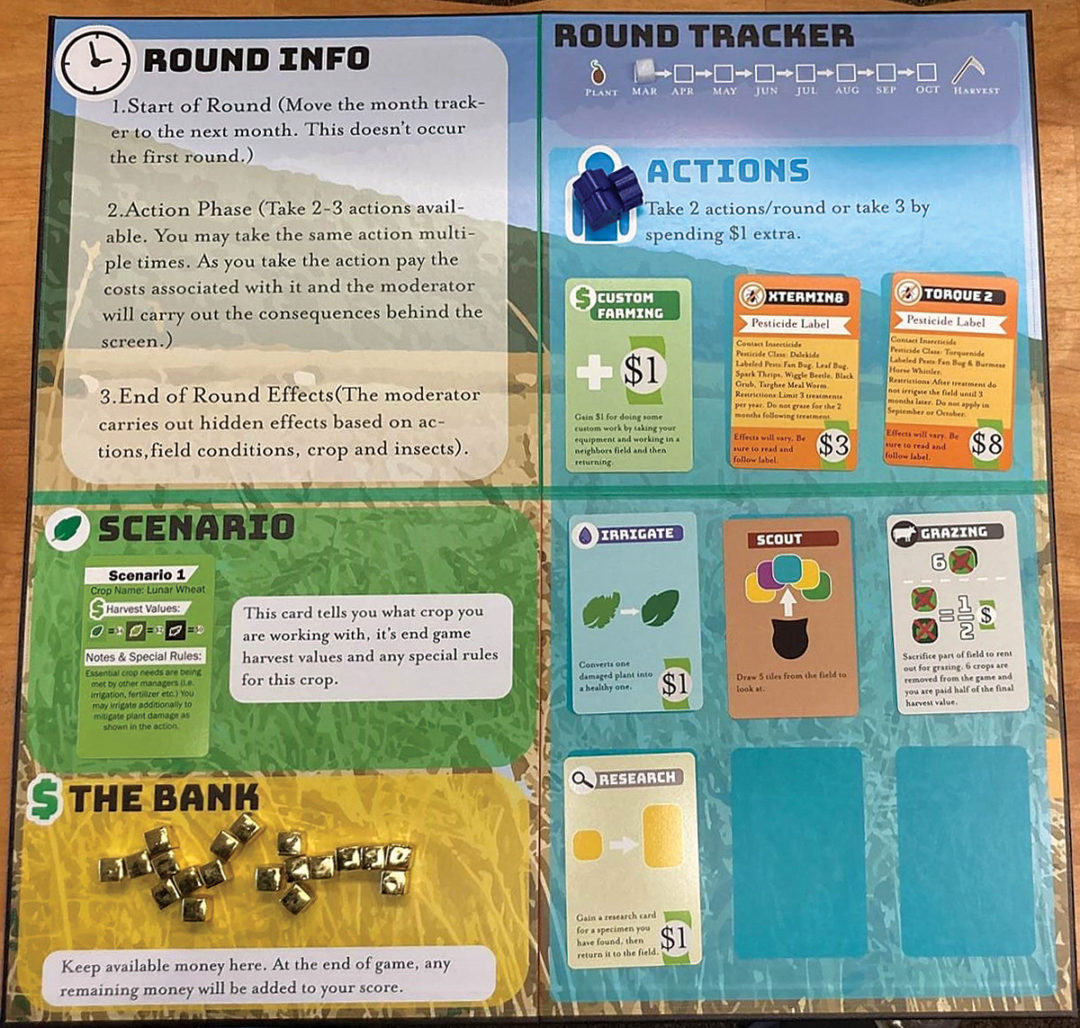Actual farmers don’t plant lunar wheat, and they’ll never encounter fan bugs or bog beetles when they scout their fields.
Despite the fictitious details, anyone who plays the new agricultural-themed board game Pest Friends can count on learning real lessons in integrated pest management. The educational strategy game, which challenges two or more players to grow a profitable crop in the face of pressures from insects, was created by University of Idaho (U of I) Extension educators Jason Thomas and Grant Loomis.
Thomas, an entomologist based in Minidoka County; and Loomis, a soil health specialist based in Blaine County, went to great lengths to make Pest Friends as true to life as possible. They did such a good job that Pest Friends has already been incorporated into agricultural curriculum at the College of Southern Idaho in Twin Falls and Texas A&M University in College Station, Texas. Furthermore, the Idaho State Department of Agriculture awarded two pesticide applicators’ credits to each professional who played the game during last winter’s Idaho Potato Conference in Pocatello.
“The fun of the game is letting people experience consequences. Then we can dive deep into what they did wrong and what they can do better,” Thomas said.
They started working on Pest Friends in the spring of 2020 amid COVID-19 shutdowns, reasoning it was the right time to unveil a farm simulation board game as a teaching tool. They received a $400 mini-grant through Idaho Sustainable Agriculture Research and Education (SARE) toward prototype development. Impressed by the results, Western SARE gave them another grant a few months ago for $100,000 to continue refining their product and to make 600 more sets of the game with updated artwork.
“I hope teachers across the U.S. and other places will get copies of this game and will be using it to teach youth and adults how to do pest management,” Thomas said. “I’m making something exciting and new, and I’ve enjoyed breaking the mold and doing something different.”
A designated moderator starts the game by setting a scenario: For example, three species of insects – beneficial, neutral and harmful – move into a stand of lunar wheat. Thomas and Loomis chose fictitious names to avoid expert players’ preconceived notions about actual crops and pests. Pesticides available in the game, such as Buzzkill and Xtermin8, are also pretend but are loosely based on actual chemicals.
 University of Idaho employees learn how to play Pest Friends in
Moscow in early April, led by U of I Minidoka County Extension educator
Jason Thomas, seated at the table. Photo by Grant Loomis.
University of Idaho employees learn how to play Pest Friends in
Moscow in early April, led by U of I Minidoka County Extension educator
Jason Thomas, seated at the table. Photo by Grant Loomis.Participants play action cards during each round to engage in farm activities that affect crop health and the reproduction of pest populations, such as irrigation and pesticide application. They may play an extra action card if they’re willing to pay to hire extra labor.
Choices may have unintended consequences. Using a certain insecticide may also kill beneficial insects, leading populations of bad bugs to flare up, and regulators punish farmers who don’t adhere to pesticide labels. Players can earn extra money by custom farming for another producer, but they also risk introducing new pests into their own fields via contaminated equipment.
Players may scout their fields by drawing tiles with information on their crop from a bag. In the worst fields, a player’s best choice may simply be to cut losses and allow cattle to graze their wheat. The aim is to end the game with as close to $99 as possible.
“There are a lot of negative connotations about pesticides now, and understanding pesticides, that’s a big part of it,” Loomis said.
Thomas and Loomis have had a few hundred players already test their game, tweaking the rules as needed based on any stumbling blocks they observe. Loomis has taken Pest Friends into Blaine County schools as part of that vetting process, working with the general student body rather than students in agricultural programs. The experience has opened the door to conversations with students about where food comes from in general, as well as why they should care about agriculture.
Thomas is a board game enthusiast who incorporated concepts of Dungeons and Dragons and his favorite deck-building games into the rules of Pest Friends, which is more complicated than the average board game but has still received rave reviews.
Most farmers and pesticide applicators who have played Pest Friends were initially skeptical but were quickly won over. To lend authenticity to the various consequences of actions taken in the game, Thomas ran more than 60 simulations using spreadsheets, factoring in pest reproduction rates and how they’re affected by several variables.
Jeff Miller, who conducts farm chemical trials with Rupert-based Miller Research, admits he could have performed better when he tried the game and sees potential for it to benefit people of all backgrounds.
“One of the great things it did is that when you make a decision to use a pesticide, what are the potential unintended consequences of using that pesticide?” Miller said. “The other thing brought out in that game was: How can you use research and scientific knowledge to improve your practices in what you’re doing?”
Perhaps a greater endorsement for the game, however, came from Miller’s 12-year-old son, who said he’d play Pest Friends again.
Thomas and Loomis plan to update the game with scenarios for fruit and livestock production. Within a year, they hope to have a Pest Friends version available on a mobile app.
Anyone interested in purchasing Pest Friends or in offering feedback may email Thomas or Loomis. Proceeds will be used to further expand and develop Pest Friends, in addition to creating future agricultural games.
The University of Idaho, home of the Vandals, is Idaho’s land-grant, national research university. From its residential campus in Moscow, U of I serves the state of Idaho through educational centers in Boise, Coeur d’Alene and Idaho Falls, nine research and extension centers, plus extension offices in 42 counties. Home to nearly 11,000 students statewide, U of I is a leader in student-centered learning and excels at interdisciplinary research, service to businesses and communities, and in advancing diversity, citizenship and global outreach. U of I competes in the Big Sky and Western athletic conferences. Learn more at www.uidaho.edu




.jpg?t=1687979285&width=640)



